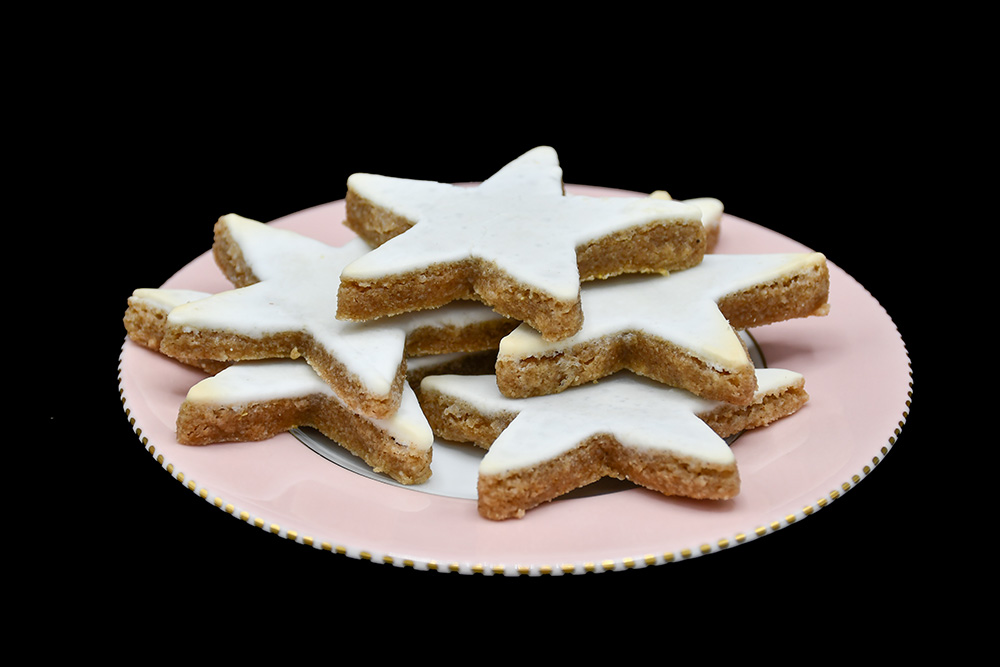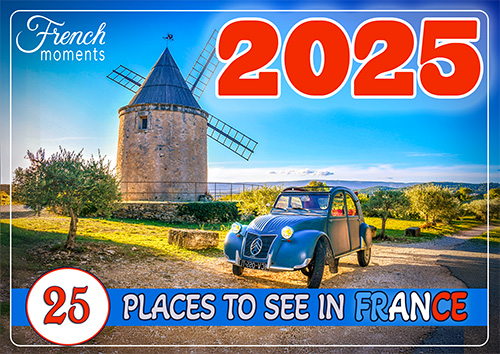Zimtsterne (literally cinnamon stars) are among the most iconic German Christmas cookies.
Fragrant with cinnamon, almonds, and a hint of lemon zest, these snowy white stars appear every December in bakeries and Christmas markets throughout Germany — and also across Alsace, where German and French holiday traditions meet.
One of the most charming things about Zimtsterne is that they are naturally gluten-free, since they contain no wheat flour at all.
Their chewy texture comes from finely ground almonds and glossy royal icing — the perfect combination of nutty sweetness and spice.
Zimtsterne: the Recipe
I’ve personally tested this Zimtsterne recipe, following Barbara’s wonderful instructions from My German Recipes.
The photos you see are my own — proof that these delightful cookies look as good as they taste!
For years, I had been searching for a reliable Zimtsterne recipe.
The ones I tried before never quite worked: sometimes the almond mixture stayed underbaked, other times the royal icing turned brown on top.
I spent hours looking online for a version that truly delivered — and finally, last year, I found Barbara’s recipe.
It worked perfectly from the very first try, and I’ve been using it ever since.
It’s definitely a lot of work, though — and since I’m not exactly a seasoned baker, I had to stay focused and follow each step carefully!
But the result was absolutely worth it.
If you take your time and follow the process, you’ll be rewarded with some of the most delicious Christmas cookies you’ve ever tasted.
I didn’t have the exact cookie cutters that Barbara used, so my stars ended up with slightly longer and thinner points.
For best results, try to find cookie cutters similar to hers — it makes shaping and glazing much easier.
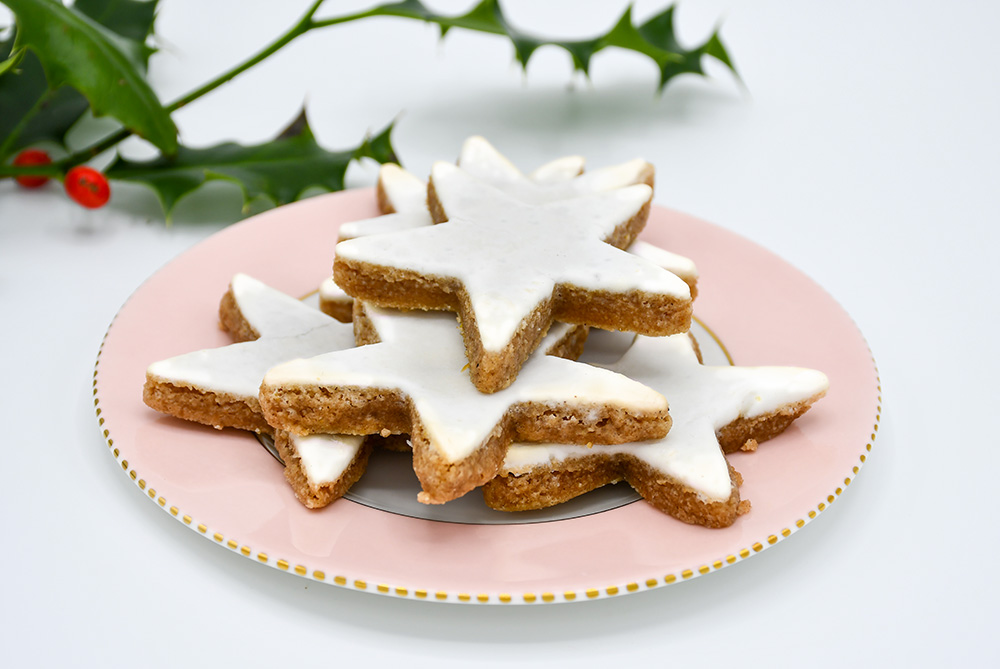
The History of Zimtsterne
The history of Zimtsterne (German for “cinnamon stars”) is deeply intertwined with the arrival of exotic spices and evolving culinary customs in Central Europe.
Their story stretches back to the Renaissance and became fully embedded in Christmas traditions during the 19th century.
1. Origins as a Luxury Sweet (16th–17th Centuries)
Zimtsterne are among the oldest traditional German cookies (Plätzchen), with roots traced to Swabia, in southwest Germany, and to German-speaking regions like Alsace and Switzerland.
The earliest written mentions date back to 1536, when “cinnamon stars” were reportedly served as a delicacy to Emperor Charles V during a visit to Cardinal Lorenzo Campeggio.
At that time, cinnamon and almonds were rare and costly imports from Asia and the Mediterranean, available only to the wealthy.
This made Zimtsterne a luxury treat, reserved for nobility, merchants, or grand festive occasions — certainly not everyday fare.
2. From Luxury to Christmas Tradition (18th–19th Centuries)
Over the following centuries, Zimtsterne gradually transformed from an exclusive luxury into a beloved Christmas classic.
By the 18th century, recipes appeared in cookbooks from Basel, Switzerland, showing that the cookie had entered the broader European culinary scene, though it remained a festive indulgence.
As global trade expanded, cinnamon became more affordable, and the middle class began incorporating spiced cookies into their holiday baking (Weihnachtsbäckerei).
During the 19th century, when the Christmas tree (Tannenbaum) and domestic holiday traditions spread through German households, Zimtsterne became inseparable from the season.
Their star shape symbolised the Star of Bethlehem, while their snowy white meringue glaze evoked the winter landscape of a traditional Christmas scene.
Another distinctive feature was their naturally gluten-free composition — made entirely from almonds, sugar, and egg whites — giving them a chewy, nutty texture unlike other cookies that relied on wheat flour.
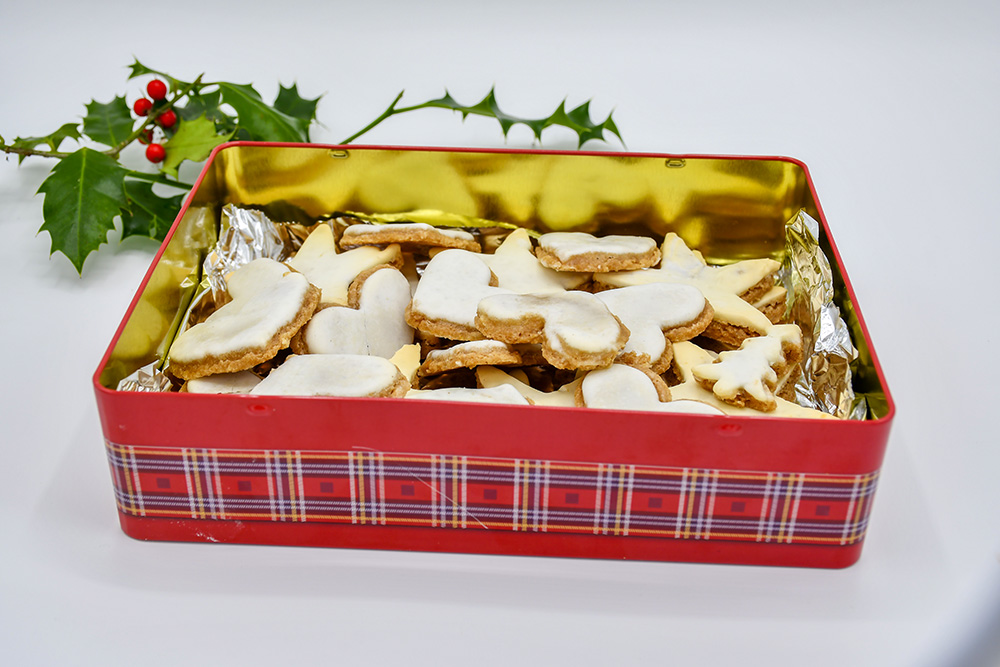
3. Recipe and Regional Variations
The basic formula for Zimtsterne has changed little over the centuries. Its simplicity and balance of spice, nuts, and sweetness continue to define its charm.
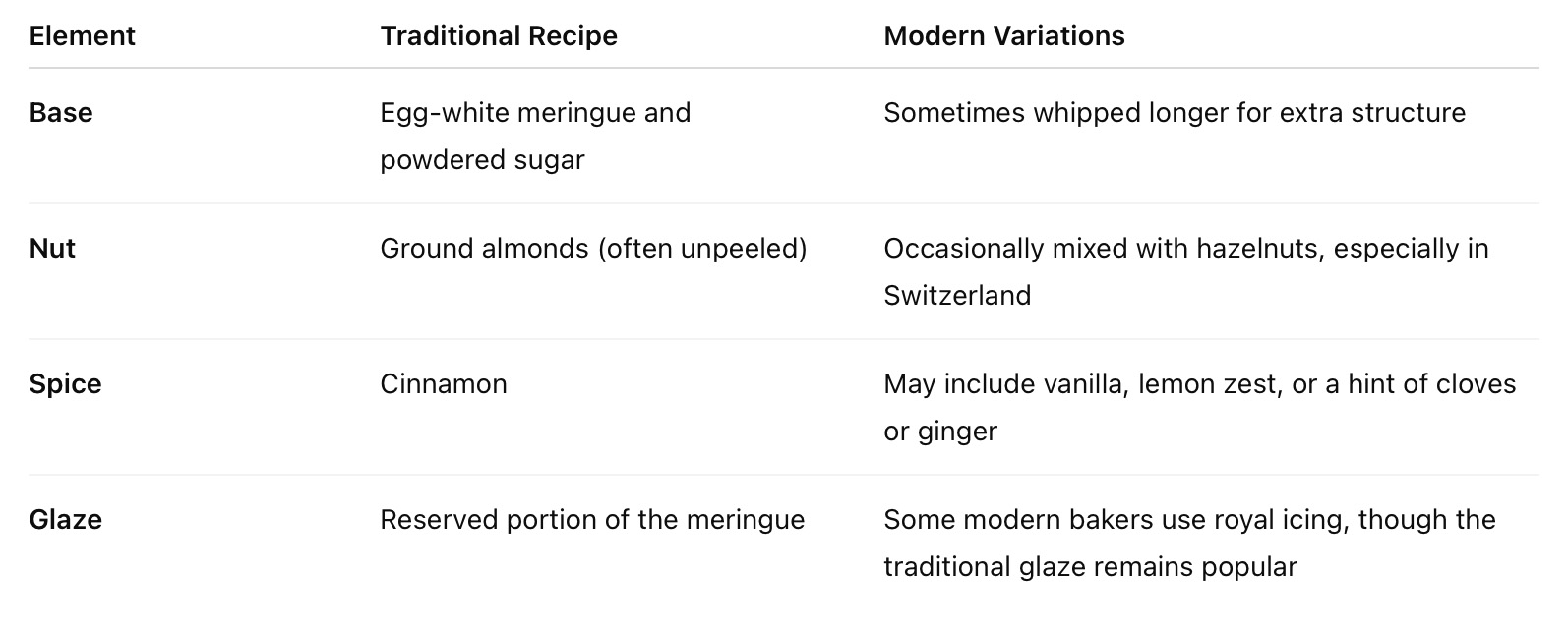
Today, Zimtsterne are a symbol of Advent across Germany, Switzerland, and Alsace.
They fill bakeries and Christmas markets (Christkindelsmärkte) with their warm aroma — a timeless reminder of festive joy, craftsmanship, and the enduring charm of European Christmas baking.
Ingredients
For the dough:
- 400 g (about 4 cups) finely ground almonds
- 390 g (2 cups) granulated sugar
- 12 g (2 tsp) ground cinnamon — ideally Ceylon cinnamon
- Zest of 1 organic lemon (optional but recommended)
- 3 egg whites
For the royal icing:
- 2 egg whites
- 250 g (2 cups) confectioner’s sugar (or ideally 5× the weight of your egg whites)
A note about cinnamon:
When it comes to cinnamon, not all types are the same.
Most store-bought cinnamon is Cassia cinnamon, which has a stronger flavour but contains coumarin — a natural compound that can be harmful to the liver if consumed in large quantities.
For safer and more authentic results, choose Ceylon cinnamon (often called “true cinnamon”). It’s milder, more aromatic, and the one traditionally used in Alsatian Christmas baking.
Instructions
Prepare the almond dough:
1. In a large bowl, combine the ground almonds, cinnamon, lemon zest, and sugar.
2. Add the egg whites and mix well — using your hands or a mixer — until a sticky dough forms.
3. Shape it into a rectangle, wrap it in beeswax paper or plastic wrap, and refrigerate for at least 4–6 hours, ideally overnight.
Make the royal icing:
4. Beat the 2 egg whites until fluffy but not stiff.
5. Gradually add the confectioner’s sugar and mix until smooth, glossy, and spreadable.
6. Adjust consistency as needed — it should be thick enough to stay on the dough without running.
Roll out the dough and glaze:
7. Dust your work surface lightly with almond flour.
8. Roll out the chilled dough evenly to about 1 cm (⅓ inch) thickness.
9. Spread the royal icing evenly over the entire surface of the dough.
10. Place the glazed dough (still flat) in the freezer for 2 hours to firm up before cutting.
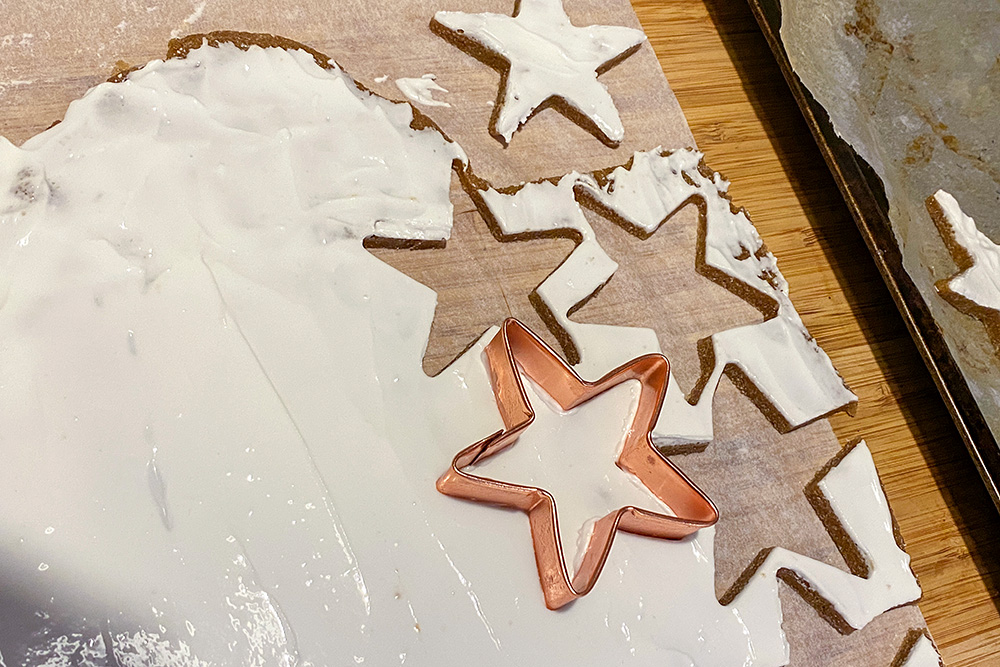
Cut the stars:
11. Dip a star-shaped cookie cutter in warm water (wipe excess).
12. Cut out stars and carefully transfer them to a parchment-lined baking sheet.
13. Re-roll scraps if desired, adding a little almond flour and more icing if needed.

Dry and bake:
14. Let the cookies dry for 2 hours at room temperature before baking — this helps set the icing.
15. Preheat your oven to 180 °C (350 °F).
16. Bake for 6–8 minutes on a lower rack, until the icing stays white and the cookies lift easily from the tray. Avoid browning the tops.
17. Allow to cool completely on a wire rack.
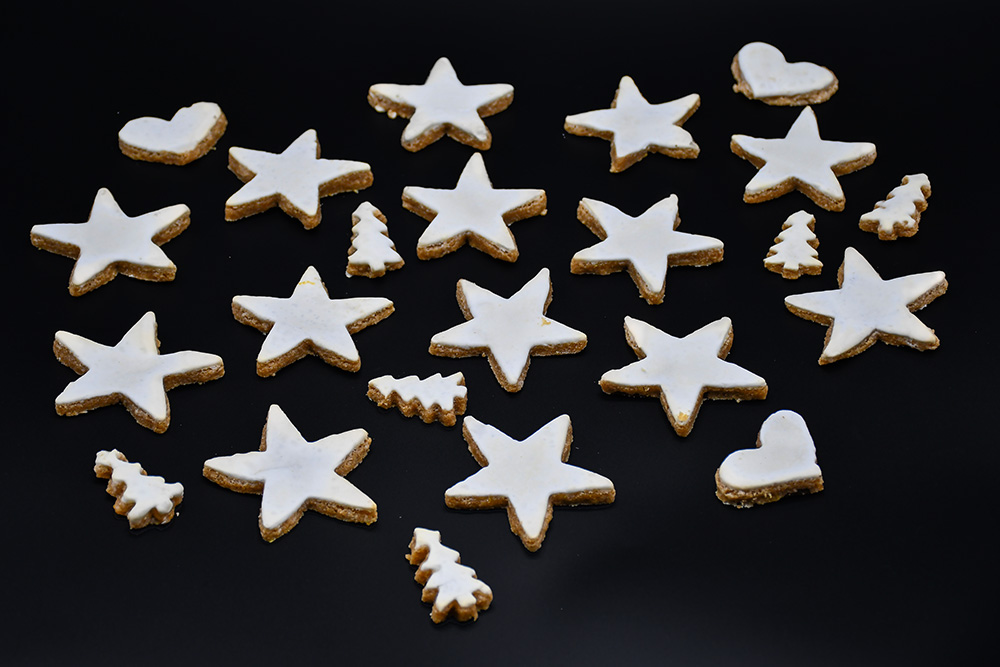
Final Words about Zimtsterne
Zimtsterne are a cherished treat in German and Alsatian Christmas baking.
Their delicate balance of almond, cinnamon, and sweet icing embodies the warmth and fragrance of the festive season.
They keep wonderfully well — once fully cooled, store them in an airtight tin to enjoy throughout Advent.
Whether you serve them with mulled wine at a Christmas market or with tea by the fire, these gluten-free cinnamon stars will fill your home with the comforting aroma of Christmas.
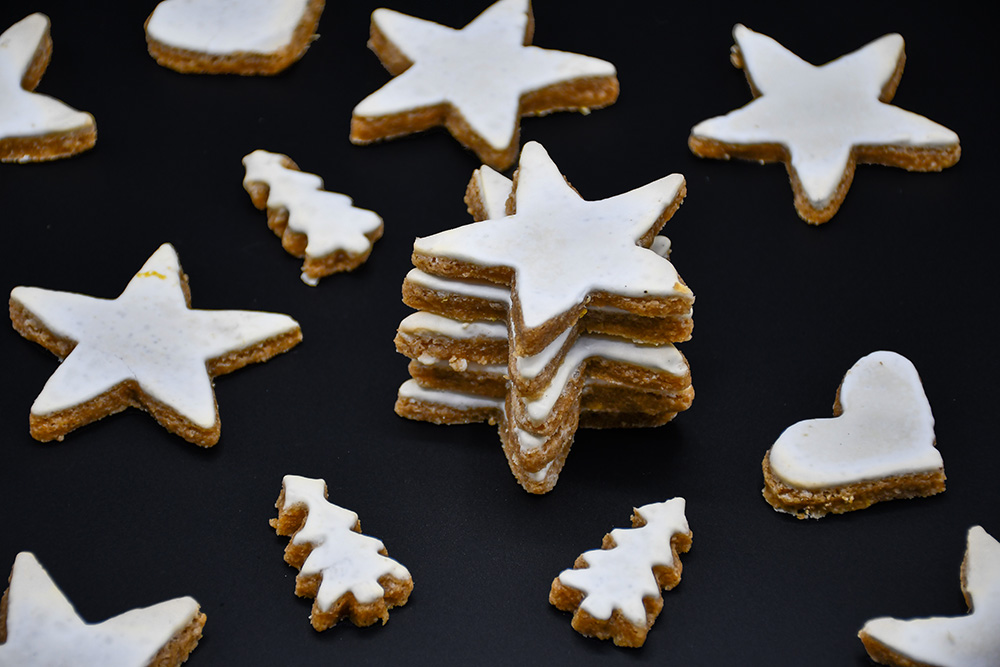
Find out more!
Check out all our Christmas recipes on the blog!
Learn more about the traditions of Alsatian Christmas Cookies
Read it in French! More French Christmas traditions and celebrations
Did you enjoy this recipe?
If so, share it on Facebook, X or pin it on Pinterest:


